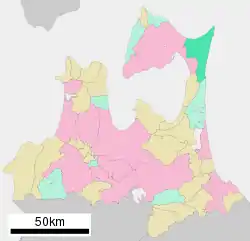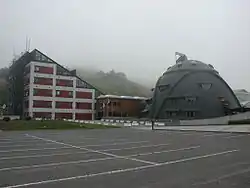Higashidōri
Higashidōri (東通村, Higashidōri-mura) is a village located in Aomori, Japan. As of 31 March 2020, the village had an estimated population of 6,254, and a population density of 20.7 persons per km² in 2815 households.[1] Its total area is 295.27 square kilometres (114.00 sq mi).[2]
Higashidōri
東通村 | |
|---|---|
 Shiriyazaki Lighthouse & Kandachime horses | |
 Flag  Seal | |
 Location of Higashidōri in Aomori Prefecture | |
 Higashidōri | |
| Coordinates: 41°16′41″N 141°19′46″E | |
| Country | Japan |
| Region | Tōhoku |
| Prefecture | Aomori |
| District | Shimokita |
| Area | |
| • Total | 295.27 km2 (114.00 sq mi) |
| Population (March 31, 2020) | |
| • Total | 6,254 |
| • Density | 21/km2 (55/sq mi) |
| Time zone | UTC+9 (Japan Standard Time) |
| City symbols | |
| • Tree | Japanese yew |
| • Flower | Iris |
| • Bird | Slaty-backed gull |
| Phone number | 0175-27-2111 |
| Address | 5-34 Isogomata Sawanai,Higashidōri-mura, Shimokita-gun, Aomori-ken 039-4292 |
| Website | Official website |

Geography
Higashidōri occupies the northeastern coastline of Shimokita Peninsula, facing the Pacific Ocean to the east and Tsugaru Strait to the north, with Cape Shiriya forming a boundary between the two waters. Parts of the village are within the limits of the Shimokita Hantō Quasi-National Park. In the year 2002, the Ministry of the Environment classified some tidal flats of the Higashidōri shoreline to be one of the 500 Important Wetlands in Japan and an important wintering place for Brent geese[3]
Climate
The village has a cold Humid continental climate characterized by cool short summers and long cold winters with heavy snowfall (Köppen climate classification Dfb). The average annual temperature in Higashidōri is 8.6 °C. The average annual rainfall is 1268 mm with September as the wettest month. The temperatures are highest on average in August, at around 21.4 °C, and lowest in January, at around -3.0 °C.[4]
Demographics
Per Japanese census data,[5] the population of Higashidōri peaked around the year 1960, and has declined over the past 60 years.
| Year | Pop. | ±% |
|---|---|---|
| 1920 | 7,387 | — |
| 1930 | 8,377 | +13.4% |
| 1940 | 9,514 | +13.6% |
| 1950 | 10,761 | +13.1% |
| 1960 | 12,449 | +15.7% |
| 1970 | 10,735 | −13.8% |
| 1980 | 9,975 | −7.1% |
| 1990 | 8,794 | −11.8% |
| 2000 | 7,975 | −9.3% |
| 2010 | 7,253 | −9.1% |
History
The area around Higashidōri was inhabited by the Emishi people, with archaeological remains dating to the Jōmon period. During the Edo period, it was controlled by the Nambu clan of Morioka Domain, but was a sparsely populated area with scattered fishing hamlets. With the establishment of the modern municipalities system on 1 April 1889, Higashidōri Village was proclaimed from the merger of twelve small hamlets, although the village administrative center was kept within the town hall of neighboring Tanabu Town (now part of the city of Mutsu). In 1988, to celebrate its 100th anniversary as a village, a village hall was finally built within the borders of Higashidōri.
Government
Higashidōri has a mayor-council form of government with a directly elected mayor and a unicameral village council of 14 members. Higashidōri is part of Shimokita District which, together with the city of Mutsu, contributes three members to the Aomori Prefectural Assembly. In terms of national politics, the city is part of Aomori 1st district of the lower house of the Diet of Japan.
Education
Higashidōri has one public elementary school and one public middle school operated by the town government. The village does not have a high school.
Economy
The economy of Higashidōri was traditionally almost completely dependent on commercial fishing. However, since the 1980s, there has been massive investment from Tōhoku Electric Power Company and Tokyo Electric Power Company towards the construction of the Higashidōri Nuclear Power Plant and related support facilities. In addition, the Iwaya Wind Farm, with a total generation capacity of 32.5 MW, is the largest in Japan.[6][7]
Local attractions
- Cape Shiriya
- Shiriyazaki Lighthouse
- Sarugamori Sand Dunes
- Hamashiriya Shell Mound, a National Historic Site[8]
References
- Higashidōri Village official statistics.
- 詳細データ青森県東通村. 市町村の姿 グラフと統計でみる農林水産業 (in Japanese). Ministry of Agriculture, Forestry and Fisheries. 2016. Retrieved 13 July 2017.
- "500 Important Wetlands in Japan". No. 63 Northern Shimokita-hanto Nearshore Waters. The Ministry of the Environment, Japan. 2002. Archived from the original on 6 January 2013. Retrieved 4 March 2017.
- Higashidōri climate data
- Higashidōri population statistics
- http://www.kajima.co.jp/topics/news_notes/vol21/v21a.htm
- Eco Power home page
- "浜尻屋貝塚 はましりやかいづか". Cultural Heritage Online (in Japanese). Agency for Cultural Affairs. Retrieved 25 December 2016.(in Japanese)
External links
![]() Media related to Higashidōri, Aomori at Wikimedia Commons
Media related to Higashidōri, Aomori at Wikimedia Commons
- Official website (in Japanese)